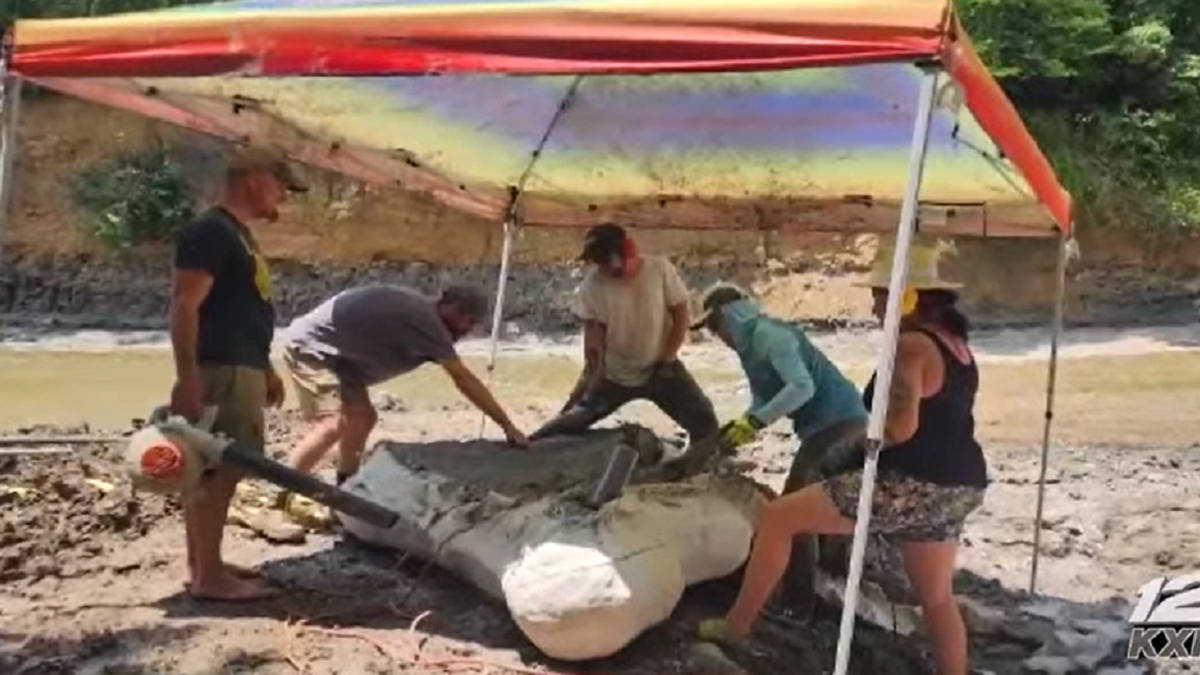
A Texas woman stumbled upon fossilized bones of a Loch Ness Monster-like dinosaur in her backyard. Pic credit: KXII-TV News 12/YouTube
A woman walking on her property in Lamar County, Texas, stumbled upon the fossil remains of two dinosaur species. Experts who came to extract the fossils described one as a “large marine reptile similar to the Loch Ness Monster.”
The dinosaur fossils belonged to a Plesiosaur. Many Loch Ness Monster enthusiasts believe that Nessie is a Plesiosaur that survived from prehistoric times.
Aimee Roberts stumbled on the fossils while taking a walk
Aimee Roberts told KXII-TV News 12 that she was walking on her property when she noticed something unusual in the ground. The patch of ground appeared to have something embedded in it.
She examined it and concluded that the strange objects looked like giant vertebrae. Suspecting she might have stumbled on fossil remains of scientific value, she contacted experts at the Texas Through Time Fossil Museum.
Andre Lujan, the head of the museum, brought his team to examine the site. They confirmed that the objects were dinosaur fossils.
Two dinosaur fossils in the ground
Lujan confirmed that he and his team of paleontologists found two dinosaur fossils in the ground. He said the first was a marine dinosaur known as a Plesiosaur.
“This is a large marine reptile similar to the loch ness monster, but with a shorter neck,” he said. “This is a very rare animal in the fossil record.”
The second fossil was a skull belonging to a Mosasaur. The ancient Mosasaurs were predatory marine reptiles that became extinct 66 million years ago.
Lujas told KXII-TV News that they would display the fossils at the museum.
Many enthusiasts believe Nessie is a Plesiosaur
Many Loch Ness Monster enthusiasts believe that Nessie, supposedly native to Loch Ness in the Scottish Highlands, is a Plesiosaur.
Plesiosaurs were marine mammals that flourished during the Mesozoic Era, about 252 million to 66 million years ago.
They first appeared in the fossil records in the late Triassic Period (c. 200 million years ago) of the Mesozoic and became widely distributed in the oceans during the Jurassic Period (200 million to 146 million years ago).
Plesiosaurs disappeared from the fossil records in the period coinciding with the great extinction at the end of the Cretaceous Period (c. 66 million years ago).
They spread into various marine environments, including inland and freshwater lakes, at the height of their global distribution.
Some Loch Ness Monster experts believe that a small population of the order Plesiosauria that inhabited the Scottish freshwater lakes survived until modern times and became known as the Loch Ness Monster.
Eyewitness descriptions of Nessie allegedly match ancient Plesiosaurs
Alleged eyewitness descriptions of the Loch Ness Monster match the ancient Plesiosaur, enthusiasts claim.
Plesiosaurs were water-dwelling but air-breathing mammals. They needed to come to the surface at regular intervals to breathe.
Loch Ness Monster enthusiasts claim it explains why Nessie sightings are common. People see the monster frequently because it must surface regularly to breathe air.
The ancient Plesiosaurs had long necks, small heads, and flippers instead of legs. But some had short necks and large heads.
